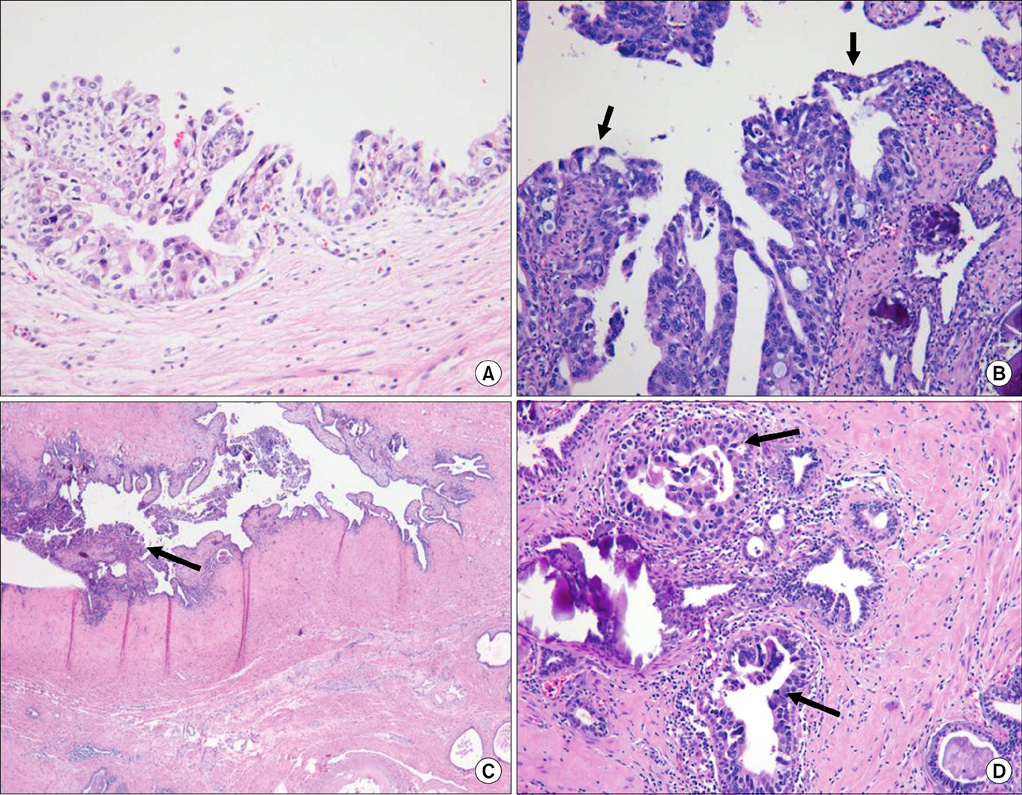Korean J Urol.
2012 May;53(5):368-370.
Seminal Vesicle Involvement by Urothelial Carcinoma in Situ of the Bladder with Mucosal Spread Pattern: A Case Report
- Affiliations
-
- 1Department of Pathology, Chungbuk National University Hospital, Cheongju, Korea. ok5218@hanmail.net
- 2Department of Urology, Chungbuk National University Hospital, Cheongju, Korea.
Abstract
- Mucosal spreading of urothelial tumors to the seminal vesicles is very rare. We experienced a case of mucosal involvement of the seminal vesicles by a bladder tumor in a 72-year-old man. The patient had a history of transurethral resection for invasive urothelial carcinoma of the bladder 8 years previously. Radical cystoprostatectomy was performed owing to recurrent and multiple urothelial carcinoma in situ. Microscopically, the urothelial carcinoma in situ was throughout the mucosa of the urinary bladder, both ureters, the prostate, and the left seminal vesicle. To date, the implication of mucosal involvement of the seminal vesicles by urothelial carcinoma is unclear. However, careful microscopic examination is needed to avoid an erroneous diagnosis.
MeSH Terms
Figure
Reference
-
1. Daneshmand S, Stein JP, Lesser T, Quek ML, Nichols PW, Miranda G, et al. Prognosis of seminal vesicle involvement by transitional cell carcinoma of the bladder. J Urol. 2004. 172:81–84.2. Montie JE, Wojno K, Klein E, Pearsall C, Levin H. Transitional cell carcinoma in situ of the seminal vesicles: 8 cases with discussion of pathogenesis, and clinical and biological implications. J Urol. 1997. 158:1895–1898.3. Ro JY, Ayala AG, el-Naggar A, Wishnow KI. Seminal vesicle involvement by in situ and invasive transitional cell carcinoma of the bladder. Am J Surg Pathol. 1987. 11:951–958.4. Volkmer BG, Kufer R, Maier S, Bartsch G Jr, Bach D, Hautmann R, et al. Outcome in patients with seminal vesicle invasion after radical cystectomy. J Urol. 2003. 169:1299–1302.5. Revelo MP, Cookson MS, Chang SS, Shook MF, Smith JA Jr, Shappell SB. Incidence and location of prostate and urothelial carcinoma in prostates from cystoprostatectomies: implications for possible apical sparing surgery. J Urol. 2004. 171(2 Pt 1):646–651.6. Ormsby AH, Haskell R, Jones D, Goldblum JR. Primary seminal vesicle carcinoma: an immunohistochemical analysis of four cases. Mod Pathol. 2000. 13:46–51.7. Tabata K, Irie A, Ishii D, Yanagisawa N, Iwamura M, Baba S. Primary squamous cell carcinoma of the seminal vesicle. Urology. 2002. 59:445.8. Habanec B. Monstrous epithelium in the seminal vesicles and epididymis. Cesk Patol. 1984. 20:73–78.9. Hameed O, Humphrey PA. Pseudoneoplastic mimics of prostate and bladder carcinomas. Arch Pathol Lab Med. 2010. 134:427–443.10. Esrig D, Freeman JA, Elmajian DA, Stein JP, Chen SC, Groshen S, et al. Transitional cell carcinoma involving the prostate with a proposed staging classification for stromal invasion. J Urol. 1996. 156:1071–1076.
- Full Text Links
- Actions
-
Cited
- CITED
-
- Close
- Share
- Similar articles
-
- Seminal Vesicle Involvement by Carcinoma In Situ of the Bladder: Clonal Analysis Using Next-Generation Sequencing to Elucidate the Mechanism of Tumor Spread
- Carcinoma In Situ of the Urinary Bladder with Transitional Cell Carcinoma of Prostate: A Histopathologic Study and Mapping of the Urothelial Lesions
- A Case of Seminal Vesicle Cyst
- Primary Adenocarcinoma of the Seminal Vesicle
- 1 case of seminal vesicle cyst


